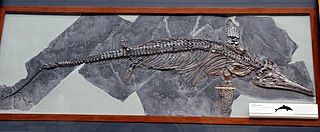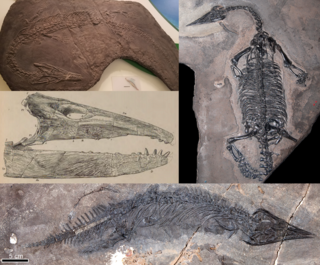 W
WAllokotosauria is a clade of early archosauromorph reptiles from the Middle to Late Triassic known from Asia, Africa, North America and Europe. Allokotosauria was first described and named when a new monophyletic grouping of specialized herbivorous archosauromorphs was recovered by Sterling J. Nesbitt, John J. Flynn, Adam C. Pritchard, J. Michael Parrish, Lovasoa Ranivoharimanana and André R. Wyss in 2015. The name Allokotosauria is derived from Greek meaning "strange reptiles" in reference to unexpected grouping of early archosauromorph with a high disparity of features typically associated with herbivory. Nesbitt et al. (2015) defined the group as a stem-based taxon containing Azendohsaurus madagaskarensis and Trilophosaurus buettneri and all taxa more closely related to them than to Tanystropheus longobardicus, Proterosuchus fergusi, Protorosaurus speneri or Rhynchosaurus articeps. Therefore, Allokotosauria includes the families Azendohsauridae and Trilophosauridae by definition, as well as the potentially more basal Pamelaria which is closer to them than to other early archosauromorphs. Pamelaria is the earliest known allokotosaur, dating to the Anisian of India. Azendohsauridae is currently represented by a single genus Azendohsaurus known from the Ladinian to Carnian of Africa, while trilophosaurids are mostly known from the Carnian to Norian stages of North America, England and potentially European Russia, though one member of the latter group, Variodens inopinatus, is known from Rhaetian. According to studies of Arctosaurus material from Cameron Island in Canada, the latter may have been an allokotosaurian because of the similarities with Azendohsaurus due to the presence of a posterior ridge from the centrum to the diapophyses which extends from the diapophysis all the way to the posterior ventrolateral corner of the centrum. This ridge overhangs a deep groove in the lateral surface of the centrum.
 W
WAnkyramorpha is an extinct clade of procolophonomorph parareptiles which lived between the early Cisuralian epoch to the latest Triassic period of Africa, Antarctica, Asia, Australia, Europe, North America and South America.
 W
WAskeptosaurus is an extinct genus of askeptosauroid, a marine reptile from the extinct order Thalattosauria. Askeptosaurus is known from several well-preserved fossils found in Middle Triassic marine strata in what is now Italy and Switzerland.
 W
WCrurotarsi is a clade of archosauriform reptiles that includes the archosaurs and the extinct, crocodile-like phytosaurs. Prior to 2011, the name had instead been used to refer to archosaurs closer to crocodilians than to birds and other dinosaurs. An equivalent term for the crocodilian side of the archosaur family tree is Pseudosuchia. This traditional definition of Crurotarsi assumed that phytosaurs were true archosaurs and more closely related to crocodilians than to birds. However, a 2011 study argued that the phytosaur lineage evolved prior to the split between birds and crocodilians. This would mean that phytosaurs were not true archosaurs, and therefore could not be considered representatives of croc-line archosaurs. Crurotarsi was redefined to pertain to the larger archosauriform group which included Phytosauria and Archosauria. Under this definition, Crurotarsi would also include avemetatarsalians alongside the pseudosuchians and phytosaurs.
 W
WEuparkeriidae is an extinct family of small carnivorous archosauriforms which lived from the Early Triassic to the Middle Triassic (Anisian). While most other early archosauriforms walked on four limbs, euparkeriids were probably facultative bipeds that had the ability to walk on their hind limbs at times. The most well known member of Euparkeriidae is the species Euparkeria capensis, which was named by paleontologist Robert Broom from the Karoo Basin of South Africa in 1913 and is known from several nearly complete skeletons. The family name was first proposed by German paleontologist Friedrich von Huene in 1920; Huene classified euparkeriids as members of Pseudosuchia, a traditional name for crocodilian-line archosaurs from the Triassic. However, phylogenetic analyses performed in the 21st century place Euparkeriidae as a group of Archosauriformes, a position outside Pseudosuchia and close to the ancestry of both crocodile-line archosaurs and bird-line archosaurs. However, they are probably not direct ancestors of archosaurs.
 W
WIchthyosaurs are large extinct marine reptiles. Ichthyosaurs belong to the order known as Ichthyosauria or Ichthyopterygia.
 W
WNothosauridae are an extinct family of carnivorous aquatic sauropterygian reptiles from the Triassic time period of China, France, Germany, Israel, Italy, Netherlands, Russia, Switzerland, and northern Africa.
 W
WParareptilia is a subclass or clade of basal sauropsids (reptiles), typically considered the sister taxon to Eureptilia. Parareptiles first arose near the end of the Carboniferous period and achieved their highest diversity during the Permian period. Several ecological innovations were first accomplished by parareptiles among reptiles. These include the first reptiles to return to marine ecosystems (mesosaurs), the first bipedal reptiles, the first reptiles with advanced hearing systems, and the first large herbivorous reptiles. The only parareptiles to survive into the Triassic period were the procolophonoids, a group of small generalists, omnivores, and herbivores. The largest family of procolophonoids, the procolophonids, rediversified in the Triassic and continued to be successful until their demise in the Triassic-Jurassic mass extinction.
 W
WPolonosuchus is a genus of rauisuchid known from the late Triassic of Poland. It was a huge predator about 5–6 metres in length and, like all rauisuchians, was equipped with a large head of long sharp teeth. The legs were placed almost underneath the body, unlike most reptiles, which would have made it quite fast and a powerful runner. The appearance was very similar to that of the more known Postosuchus, of North America, and shared with the latter the ecological niche of the apex predator.
 W
WThe Procolophonia are a suborder of herbivorous reptiles that lived from the Middle Permian till the end of the Triassic period. They were originally included as a suborder of the Cotylosauria but are now considered a clade of Parareptilia. They are closely related to other generally lizard-like Permian reptiles such as the Millerettidae, Bolosauridae, Acleistorhinidae, and Lanthanosuchidae, all of which are included under the Anapsida or "Parareptiles".
 W
WProtorosauria is an extinct polyphyletic group of archosauromorph reptiles from the late Permian to the start of the Late Triassic of Asia, Europe, North America. It was named by the English anatomist and paleontologist Thomas Henry Huxley in 1871 as an order, originally to solely contain Protorosaurus. Other names which were once considered equivalent to Protorosauria include Prolacertiformes and Prolacertilia.
 W
WRhynchosaurs are a group of extinct herbivorous Triassic archosauromorph reptiles, belonging to the order Rhynchosauria. Members of the group are distinguished by their triangular skulls and elongated, beak like premaxillary bones. Rhynchosaurs first appeared in the Middle Triassic or possibly the Early Triassic, before becoming abundant and globally distributed during the Carnian stage of the Late Triassic.
 W
WTanystropheidae is an extinct family of mostly marine archosauromorph reptiles that lived throughout the Triassic Period. They are characterized by their long, stiff necks formed from elongated cervical vertebrae with very long cervical ribs. Some tanystropheids such as Tanystropheus had necks that were several meters long, longer than the rest of their bodies.
 W
WThalattosauria is an extinct order of prehistoric marine reptiles that lived in the middle to late Triassic period. Thalattosaurs were diverse in size and shape, and are divided into two superfamilies: Askeptosauroidea and Thalattosauroidea. Askeptosauroids were endemic to the Tethys Ocean, their fossils have been found in Europe and China, and they were likely semiaquatic fish eaters with straight snouts and decent terrestrial abilities. Thalattosauroids were more specialized for aquatic life and most had unusual downturned snouts and crushing dentition. Thalattosauroids lived along the coasts of both Panthalassa and the Tethys Ocean, and were most diverse in China and western North America. The largest species of thalattosaurs grew to over 4 meters (13 feet) in length, including a long, flattened tail utilized in underwater propulsion. Although thalattosaurs bore a superficial resemblance to lizards, their exact relationships are unresolved. They are widely accepted as diapsids, but experts have variously placed them on the reptile family tree among Lepidosauromorpha, Archosauromorpha, ichthyosaurs, and/or other marine reptiles.
 W
WThalattosauroidea is a superfamily of thalattosaurs, a Triassic group of marine reptiles. It was named in 1904 by paleontologist John Campbell Merriam to include the genus Thalattosaurus from California. Thalattosauroids are one of two groups of Thalattosauria, the other being Askeptosauroidea. Thalattosauroids make up the "traditional" thalattosaurs with large downturned snouts, short necks, and long, paddle-like tails.
 W
WTrilophosaurs are lizard-like Triassic allokotosaur reptiles related to the archosaurs. The best known genus is Trilophosaurus, a herbivore up to 2.5 metres long. It had a short, unusually heavily built skull, equipped with massive, broad flattened cheek teeth with sharp shearing surfaces for cutting up tough plant material. Teeth are absent from the premaxilla and front of the lower jaw, which in life were probably equipped with a horny beak.